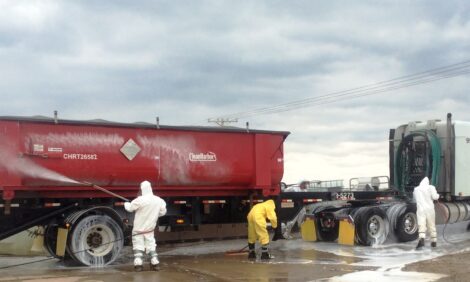



Space Allowance and Pen Size Affect Welfare Indicators and Performance of Growing Pigs under Comfort Class Conditions
Dutch researchers report adverse effects of increased group size or stocking density on the performance and welfare of pigs housed in a system offering more space than a commercial farm.Comfort Class offers each 110kg growing–finishing pig housed at 2.4 square metres with bedding in groups of 12 premium welfare to meet their behavioural needs, explain Herman Vermeer of Wageningen University in the Netherlands and co-authors in a paper published in Livestock Science.
Conventionally housed, growing–finishing pigs in the Netherlands are allowed 0.8 square metres, based on 0.035×BW0.667. The extra space offered with Comfort Class is a major financial barrier to introduce this system in practice.
In order to establish whether or not welfare and performance could be maintained whilst reducing space allowance, a 3×2 factorial trial was designed to compare pigs housed at 2.4, 1.6 or 1.2 square metres per pig in pens of 29 and 58 square metres. Video recordings, skin and tail lesions, lameness scores and performance were collected during three replicates involving 216 pigs each.
Results indicate that pigs housed at 2.4, 1.6 or 1.2 square metres per animal would be lying in the kennels for 62, 54 and 48 per cent of the time (P<0.001), respectively, and pigs housed at 2.4 square metres spent more time eating than those housed at 1.2 square metres (4.7 per cent and 4.4 per cent of the time, respectively; P<0.05).
Pigs housed in the small pens spent less time in the kennel and more time rooting than those in the large pens (53.0 per cent versus 55.8 per cent in kennel, P=0.046; 1.78 per cent versus 1.22 per cent rooting; P<0.001).
Pigs housed in the small pens had fewer tail lesions and those housed at 2.4 and 1.6 square metres tended to have fewer skin lesions on their hind legs than those housed at 1.2 square metres per pig.
Daily weight gain was higher in the small than the large pens (823 versus 797g per day; P=0.003) and higher at 2.4 and 1.6 square metres than 1.2 square metres (827 and 817 versus 786g per day; P=0.002).
Overall, Vermeer and co-authors concluded that increases in group size or stocking density had adverse effects on welfare and performance, even at these high space allowances. However, they added, performance benefits from higher space allowances did not compensate for the increase in housing costs.
Reference
Vermeer H.M., K.H. de Greef and H.W.J. Houwers. 2014. Space allowance and pen size affect welfare indicators and performance of growing pigs under Comfort Class conditions. Livestock Science. 159:79-86.
February 2014








